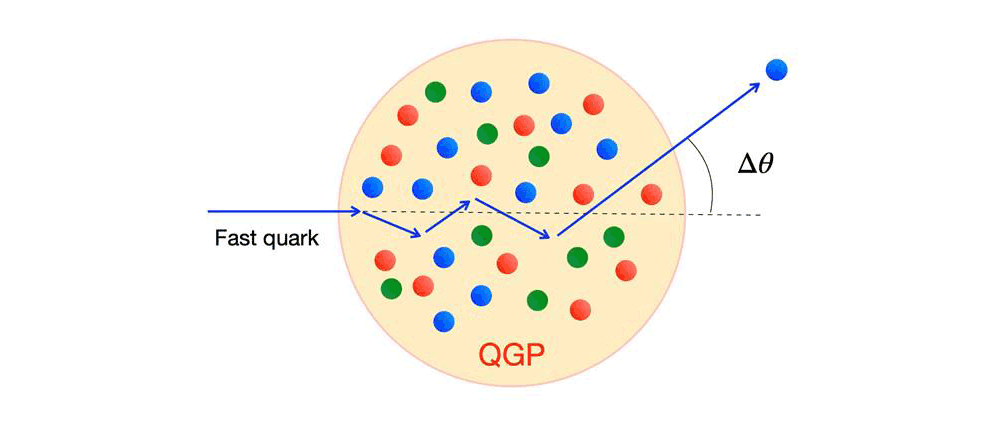Calculations Predict Surprising Quark Diffusion in Hot Nuclear Matter
New calculations suggest that high energy quarks should scatter wider and faster in hot quark matter than can be accounted for by local interactions.
August 9, 2023

When an energetic quark travels through a "soup" of "free" quarks and gluons — the quark-gluon plasma (QGP) — non-local quantum effects should cause it to scatter faster and at wider angles than expected from mere local interactions.
The Science
Scientists can use powerful colliders to smash atomic nuclei together to create a quark-gluon plasma (QGP). This “soup” of quarks and gluons, some of the fundamental building blocks of matter, filled the early universe. Tracking how high energy jets of quarks travel through the QGP can reveal information about the QGP’s properties. Scientists’ simplest assumption is that local interactions with the quarks and gluons will deflect these energetic particles. But recent theoretical calculations that also include non-local quantum interactions—those interactions beyond a particle’s immediate surroundings—predict a super-diffusive process. This means that the complex interactions in QGP deflect quarks faster and at wider angles than can be explained by local interactions alone.
The Impact
Testing these predictions at particle colliders will provide new insight into the interactions between quarks and gluons. These interactions are governed by the strong nuclear force, one of the four fundamental forces that govern the universe. The new theoretical explanation points to the importance of the non-local nature of these quantum interactions. The findings suggest that the description of the QGP as a collection of point-like particles may break down even at short distances. The discovery of the importance of longer-range quantum interactions might also offer a new perspective for understanding why the QGP flows like a nearly perfect fluid—a fluid with very low viscosity.
Summary
Scientists use particle colliders to recreate a form of early universe matter known as a QGP. Tracking how energetic jets of particles move through the QGP can reveal information about its properties. Early calculations based on the theory of strong interactions suggested that jets would undergo a diffusive process caused by random deflections as the energetic particles interacted with the quarks and gluons that make up the plasma—similar to the way pollen particles on the surface of a pond get “kicked” around by water molecules.
Counter to these early calculations, nuclear theorists at Brookhaven National Laboratory recently discovered that including non-local quantum effects—which arise from long-lived gluon fluctuations—predicts significant deviations from the expected diffusion pattern in QGP. Including these non-local effects predicts that energetic jets will undergo a super-diffusive process, broadening the angle of the jet faster than local interactions alone can explain. The predictions can be tested by tracking energetic jets in the QGP created in high-energy heavy ion collisions at the Relativistic Heavy Ion Collider (a Department of Energy user facility at Brookhaven National Laboratory) and the Large Hadron Collider in Europe.
Contact
Yacine Mehtar-Tani
Brookhaven National Laboratory
mehtartani@bnl.gov
Funding
This research was funded by the Department of Energy Office of Science, Office of Nuclear Physics and by the National Science Foundation.
Publications
Caucal, P. and Mehtar-Tani, Y., Universality aspects of quantum corrections to transverse momentum broadening in QCD media. Journal of High Energy Physics09, 023 (2022). [DOI: 10.1007/JHEP09(2022)023]
Caucal, P. and Mehtar-Tani, Y., Anomalous diffusion in QCD matter, Physical Review D 106, L051501 (2022). [DOI: 10.1103/PhysRevD.106.L051501]
2023-21395 | INT/EXT | Newsroom









